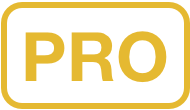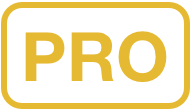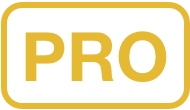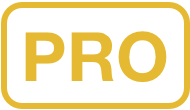Menus and Keyboard Shortcuts
This chapter explains the function of each of the items found in OmniPlan’s drop-down menus, and lists default keyboard shortcuts for them where they exist.
The OmniPlan Menu
The OmniPlan menu holds commands related specifically to the administration of the OmniPlan application itself. Check for updates, view and modify your preferences, and enter new license information here.
- About OmniPlan
- See details about your copy of OmniPlan, its licensing status, and contact information for The Omni Group. Check here to see which version of the app you are using.
- Buy OmniPlan (Trial Version Only)
- This menu item appears if you are using a trial version of OmniPlan downloaded from the Omni website, and directs you to the Omni store purchase page for the app.
- Check for Updates (Omni Store Only)
- See if there is a new version of OmniPlan available to download. You can also set up automatic checking in the Update preferences.
- Preferences (Command-,)
- Open the OmniPlan preferences window, where you can customize how the application works for you.
- Accounts
- Open the Server Accounts window, with a list of connected Project Repository and Calendar Server accounts and the OmniPlan projects synced there. Collaborative publication and subscription options are features of OmniPlan Pro.
- Licenses (Omni Store Only)
- Open the Licenses window, where you can add OmniPlan licenses you’ve bought, or check your existing licenses.
- Free Trial Mode (Trial Version Only)
- If you’re running a trial version of OmniPlan, these commands switch between the Pro and Standard versions of the app so you can compare features.
- Try Pro Edition
- Try Standard Edition
- Learn About Pro (Standard Edition Only)
- Open a window with information on the features included with the OmniPlan Pro Upgrade.
- Services
- Access system-wide macOS services offered by other applications.
- Hide OmniPlan (Command-H)
- Temporarily hide all of OmniPlan’s windows.
- Hide Others (Option-Command-H)
- Temporarily hide windows of all other applications so you can concentrate on OmniPlan.
- Show All
- Show all windows of all applications.
- Quit OmniPlan (Command-Q)
- Stop using OmniPlan and put it away for now. Your files are automatically saved.
- Quit and Close All Windows (Option-Command-Q)
- Close OmniPlan and any open project windows. Your files are saved. The next time you open OmniPlan a new document will be created (no existing projects will be opened).
- In-App Purchase (Mac App Store Only)
- Open the in-app purchase window to choose the version of OmniPlan 3 you would like to buy: the free 14-day trial, the Standard Edition, or the Pro Edition.
The File Menu
The File menu contains commands related to OmniPlan on a project data level. Create new documents, and copy, save, duplicate, restore, or otherwise manage existing ones. This menu also provides commands for getting data out of OmniPlan: printing, exporting, and reporting, publishing, and more.
- New (Command-N)
- Create a new OmniPlan project file.
- New Dashboard
 (Shift-Command-N)
(Shift-Command-N) - Create a new (empty) dashboard for comparing the status of multiple projects.
- New Dashboard From Open Projects
 (Option-Shift-Command-N)
(Option-Shift-Command-N) - Create a new dashboard pre-populated with all OmniPlan projects currently open.
- New From Template
- Create a new OmniPlan project from an existing project template.
- Open (Command-O)
- Browse for an existing OmniPlan project, dashboard, or (optionally) any file of a type that OmniPlan can open.
- Open Recent
- Open a recently accessed OmniPlan file.
- Close (Command-W)
- Close the frontmost OmniPlan window.
- Close All (Option-Command-W)
- Close all OmniPlan windows.
- Save (Command-S)
- Save any changes to the OmniPlan project or dashboard currently being edited.
- Duplicate (Shift-Command-S)
- Create an identical copy of the current file (the copy will not be saved until you choose a destination for it).
- Save As (Option-Shift-Command-S)
- Save a copy of the current file as a new file.
- Rename
- Change the title of the current file.
- Move To
- Change the location of the current file in your Mac’s directory structure.
- Save As Template
- Save the current OmniPlan project as a template that can be used as the basis for creating other new projects.
- Revert To
- Revert the current file to a previous version of the same file.
- Revert To Server Copy

- Revert the current OmniPlan project to the version stored on the server repository (if publishing and subscribing to one).
- Report (Option-Command-R)

- Open the Report window to choose a style and data set from which to generate a report of the current project.
- Export (Option-Command-E)
- Export your OmniPlan project in a variety of formats.
- Publish

- Publish the current OmniPlan project to a designated server repository (committing changes to the version of the project stored there).
- Page Setup (Shift-Command-P)
- Open the standard macOS Page Setup window, where you can change some settings for printing (or exporting to a PDF file). These settings are saved even if you quit OmniPlan.
- Print (Command-P)
- Open the standard macOS Print window, with a variety of options for printing (or creating a PDF file).
The Edit Menu
The Edit menu holds commands related to modifying the contents of tasks, resources, calendar blocks, inspector field values, and more. Cut, Copy, Paste, and Undo are all found here.
- Undo (Command-Z)
- Reverse the most recent change you made. You can keep stepping backwards like this if there are more changes you want to undo.
- Redo (Shift-Command-Z)
- Reenact the last change you undid. You can keep stepping forward through however many Undo commands you made.
- Cut (Command-X)
- Remove the selected text or items, putting them on the clipboard so you can paste them somewhere.
- Copy (Command-C)
- Put a copy of the selected text or items on the clipboard, so you can paste them somewhere.
- Copy As Link
- Put a link to the selected items on the clipboard; when you paste it, you get an address for each item.
- Paste (Command-V)
- Take whatever’s on the clipboard and insert it at the current selection. If the clipboard contains just text (not whole items), and you are editing the text of an item, the text is pasted at the insertion point. Otherwise, the contents of the clipboard are pasted as new items.
- Delete
- Remove the selected item(s) or text from your document.
- Select All (Command-A)
- Select everything in the outline, or if you are editing an item’s text, all text in the cell.
- Deselect All (Shift-Command-A)
- Clear the selection completely so that nothing is selected.
- Duplicate (Command-D)
- Make another item just like the selected one, immediately after it.
- Edit Note (Command-’)
- Move from the item text to the note area of an item, or move back from the note area to the item text.
- Attach File
- Choose a file to insert in the note area of the selected item.
- Find
-
This submenu contains the standard Find commands included in many macOS applications: Find (which opens a window where you can use regular expressions and search-and-replace), Find Next, Find Previous, Use Selection for Find (which enters the selected text as the text to search for), and Jump to Selection.
- Find (Command-F)
- Find Next (Command-G)
- Find Previous (Shift-Command-G)
- Use Selection for Find (Command-E)
- Spelling
-
This submenu contains the standard Spelling commands for the macOS spell checking system: Spelling (which opens the Spelling window), Check Spelling (which checks spelling in the document once), and Check Spelling While Typing (which turns the automatic spell checking on or off).
- Spelling (Command-:)
- Check Spelling (Command-;)
- Check Spelling As You Type
- Start Dictation (fn fn)
- With dictation enabled in ▸ System Preferences ▸ Dictation & Speech, select an editable text field and use this command to enter text via the spoken word.
- Emoji & Symbols (Control-Command-Space)
- Open the macOS Character Palette, where you can find characters not easily accessible from the keyboard, like ♆ and ☺.
The Format Menu
Styling of note text in OmniPlan is the domain of the Format menu, with options available for all common text styles you’re familiar with in macOS.
Formatting commands are only applicable in note fields.
- Show/Hide Fonts (Command-T)
- Show and hide the Fonts window.
- Bold (Command-B)
- Embolden the selected text.
- Italic (Command-I)
- Italicize the selected text.
- Underline (Command-U)
- Underline the selected text.
- Bigger (Command-+)
- Increase the size of the selected text.
- Smaller (Command-–)
- Decrease the size of the selected text.
- Show/Hide Colors (Shift-Command-C)
- Show and hide the Colors window.
- Copy Style (Option-Command-C)
- Copy the style of the selected text, so that you can apply it elsewhere with the Paste Style command. This uses a special style clipboard, so you don’t lose the data in the normal clipboard.
- Paste Style (Option-Command-V)
- Apply the style in the style clipboard (obtained using the Copy Style command) to the selected text.
The View Menu
The View menu contains options for configuring your project view on the fly. Show and hide various parts of the interface, and expand or collapse the details of items in the main outline here.
- Task View (Option-Command-1)
- Switch to Task View in the currently active project.
- Resource View (Option-Command-2)
- Switch to Resource View in the currently active project.
- Calendar View (Option-Command-3)
- Switch to Calendar View in the currently active project.
- Network View (Option-Command-4)
- Switch to Network View in the currently active project.
- Styles View (Option-Command-5)
- Switch to Styles View in the currently active project.
- Show/Hide Overview
- Show or hide the Overview bar in the currently active OmniPlan window.
- Outline
-
This submenu contains commands that customize the display of the outline in Task View.
-
Show/Hide Outline View—Show or hide the outline view along the left side of OmniPlan’s window.
-
Show/Hide Numbering—Show or hide row numbering in the outline.
-
Flat Numbering—Number each outline row with an integer (1, 2, 3, 4, etc.) regardless of parent or child status.
-
Hierarchical Numbering—Number rows according to their depth in the outline hierarchy (1, 1.1, 1.1.1, 1.1.2, etc.).
-
Always Show Full Text—Always show the full text of row titles.
-
Collapse When Not Editing—Truncate row title text to a single line when not editing the row.
-
Expand All (Control-Command-9)—Expand all rows in the outline to show any children they may have.
-
Collapse All (Control-Command-0)—Collapse all rows, hiding any children. Only top-level rows are visible.
-
Expand Rows (Command-9)—Expand the selected outline rows to reveal any children within them.
-
Collapse Rows (Command-0)—Collapse the selected rows, hiding all children.
-
- Baseline Comparison
-
With a baseline schedule set, this submenu controls how the baseline is displayed relative to the actual schedule.
-
Show Actual Schedule—Show only the actual schedule in the Gantt chart.
-
Show Baseline Schedule—Show only the baseline schedule in the Gantt chart.
-
Show Both Schedules—Show both the baseline and actual schedules as full-height bars in the Gantt chart. The baseline appears in grey, while tasks in the actual schedule retain their bar color; to the extent the baseline and actual schedules match, bars from the actual schedule overlap the baseline.
-
Show Split Schedules—Show both the baseline and actual schedules, split so each occupies half of the hight of each task row in the Gantt chart. The actual schedule occupies the top half of the row (using the original bar color) while the baseline fills the bottom half (in grey).
-
- Gantt, Timeline, or Calendar
-
This submenu contains controls for displaying various data in the Gantt chart in Task View, the Timeline in Resource View, or the Calendar in Calendar View.
-
Hide/Show Gantt, Timeline, or Calendar—Hide or show the Gantt, Timeline, or Calendar view, depending on how you are currently viewing the project.
-
Critical Path—Show or hide the critical path.
-
Resource Load—Show or hide resource loads for each resource in the timeline (Resource View only).
-
Dependency Lines—Show or hide dependency lines (Task View only).
-
Slack Lines—Show or hide slack lines (Task View only).
-
Group Shading—Turn group shading on or off (Task View only).
-
Constraints—Show or hide constraints.
-
Show Project Start—Apply shading to the chart area prior to the start of the project.
-
- Non-Working Time
-
This submenu contains options for display of non-working time in the Gantt chart (Task View) and Timeline (Resource View).
-
None—No non-working time is visually indicated.
-
Holidays—Holidays are denoted as non-working time.
-
Weekends—Weekends are denoted as non-working time.
-
All—All non-working time is denoted in the Gantt chart and Timeline.
-
- Show Scheduling Influences (Option-Command-?)
- Display a popover on the currently selected task that lists the factors influencing its schedule. (This command is only available when a single task is selected.)
- Scale To Fit Project (Option-Command-0)
- Scale the Gantt chart or Timeline to fit the entire project on a single screen.
- Scale To Fit Selection (Option-Shift-Command-0)
- Scale the Gantt chart or Timeline to maximize the space used on screen by the currently selected items.
- Zoom In (Command->)
- Scale the Gantt chart with progressively smaller time units, causing tasks to occupy more horizontal space on screen. This command only functions in Task View.
- Zoom Out (Command-<)
- Scale the Gantt chart with progressively larger time units, causing tasks to occupy less horizontal space on screen. This command only functions in Task View.
- Go to Today (Shift-Command-T)
- Navigate to the current date in the Gantt chart. This command only functions in Task View.
- Filter Tasks (Option-Command-F)
- Open the task filter dialog to create, edit, apply, or remove a filter that modifies which tasks are visible. When applied, a filter affects task visibility across all views.
- Update Current Filter
- Re-apply the current filter to the project to account for any changes made. (Newly added or edited tasks do not have the filter applied to them until the filter is refreshed.)
- Remove Filter
- Remove a currently applied filter, restoring visibility of all tasks.
- Restore Saved Filter
- Choose from the submenu here to apply a previously created and saved filter to the project.
- Focus (Shift-Command-F)
- Hide all tasks from view other than the ones currently selected (this menu item is only available when a group is selected).
- Show/Hide Toolbar
- Show or hide the toolbar.
- Customize Toolbar
- Choose which controls appear in the main window’s toolbar.
- Customize Touch Bar
- Choose which controls appear in the Touch Bar (on devices that support it).
- View Options (Command-J)
- Open View Options for the current view.
- Enter/Exit Full Screen (Control-Command-F)
- View OmniPlan at the glorious full dimensions of your screen, or return it to a modest window.
The Project Menu
The Project menu contains controls for managing a project once it is up and running.
- Set Baseline
- Create a baseline schedule from the current actual schedule of the project.
- Delete Baseline
- Delete a currently active baseline.
- Show Changes/Hide Changes (Option-Command-T)

- Show or hide the change tracking view, to oversee changes made to the project. This includes changes made locally as well as remotely by other users publishing changes to a shared server repository.
- Automatically Level Resources
- Enable (or disable) automatic resource leveling for the project. When enabled, the project is leveled every time a change is made.
- Level Resources (Shift-Command-L)
- Manually level the project to maximize scheduling and resource allocation.
- Clear Leveling
- Remove delays previously added by resource leveling, restoring tasks to their default scheduling parameters.
- Catch Up to Date (Option-Command-U)
- Mark all task work as complete up to the current date.
- Reschedule Incomplete Tasks (Shift-Command-R)
- Reschedule all tasks with incomplete work as of a specified date.
- Set Current Editing Date
- Designate a date (other than the current date) to serve as a benchmark for editing.
- Set as Default for New Tasks/Groups/Milestones
- Set the currently selected task, group, or milestone as the default configuration for newly created tasks, groups, or milestones.
- Sync & Sharing Options

- Set up publishing and subscription options for the current project.
- Publish (Control-Command-P)

- Publish local changes to the project to a shared server repository.
- Refresh (Control-Command-U)

- Refresh the project with remote changes from a shared server repository.
The Structure Menu
The Structure menu is for commands that manipulate items in your project based on their hierarchical position. This is primarily useful when working with nested tasks and groups.
- Add
-
This submenu contains commands for adding various types of tasks (in Task View) and resources (in Resource View) to the project. These commands are context dependent based on the currently selected task or resource.
-
Task/Resource (Return)—Add a new top level task to the task outline, or resource to the resource outline.
-
Dependent Task—Add a task connected to the currently selected task with a Finish → Start dependency.
-
Child Task/Resource (Command-})—Add a task or resource nested inside the current task or resource. The currently selected task or resource becomes a task or resource group.
-
Aunt Task/Resource (Command-{)—Add a task or resource at a level of hierarchy above the currently selected task or resource.
-
Group—Add an empty group task or resource to the project.
-
Dependent Group—Add an empty group task connected to the currently selected task with a Finish → Start dependency.
-
Milestone (Shift-Command-M)—Add a milestone to the project.
-
Dependent Milestone—Add a milestone connected to the currently selected task with a Finish → Start dependency.
-
Equipment Resource—Add an equipment resource to the resource list.
-
Material Resource—Add a material resource to the resource list.
-
- Move
-
These commands rearrange the currently selected item in the outline hierarchy without affecting deselected items. Move Up and Move Down change an item’s location in relation to its siblings. Move Right and Move Left increase or decrease an item’s indentation level. When items move, their descendants move with them.
- Move Down (Control-Command-Down Arrow)
- Move Right (Control-Command-Right Arrow)
- Move Up (Control-Command-Up Arrow)
- Move Left (Control-Command-Left Arrow)
- Indent (Command-])
- Move the selected item to the right, turning it into a child of the item before it in the outline.
- Outdent (Command-[)
- Move the selected item to the left, making it a sibling of what was its parent. This doesn’t change the location of the item’s former siblings; only the selected item’s position in the hierarchy is affected.
- Group (Option-Command-L)
- With one or more tasks selected, create a new group task and add any selected tasks to the group.
- Ungroup
- If any selected tasks are part of a group, remove them from the group. They become top level tasks (and may leave empty group tasks behind).
- Split Task (Option-Command-S)
- Split a currently selected task into multiple pieces with a gap between them.
- Connect Tasks
-
This submenu contains commands for creating dependency relationships between selected tasks.
- Start → Start
- Start → Finish
- Finish → Start (Control-Command-=)
- Finish → Finish
- Disconnect Tasks (Control-Command--)
- Remove any dependency relationships between the selected tasks.
- Assign Resource
- Assign a resource from the attached submenu to the selected task or tasks.
- Clear Assignments (Option-Command-Delete)
- Remove resource assignments from the selected task or tasks.
- Sort All Tasks/Resources or Sort Selected Tasks/Resources
-
This submenu contains commands for sorting a selection of tasks (in Task View) or resources (in Resource View) by various parameters.
- Title, A-Z
- Title, Z-A
- Effort, Lowest to Highest
- Effort, Highest to Lowest
The Inspectors Menu
This menu contains commands for navigating between OmniPlan’s various inspectors.
- Show/Hide Inspector (Shift-Command-I)
- Show or hide the inspector pane on the right side of the active project window.
- Project
- Open the Project inspector.
- Milestones
- Open the Milestones inspector.
- Task
- Open the Task inspector.
- Resource
- Open the Resource inspector.
- Styles
- Open the Styles inspector.
- Custom Data
- Open the Custom Data inspector.
- Attachments
- Open the Attachments inspector.
The Window Menu
This menu contains controls for opening, switching between, and otherwise manipulating the project window.
- Minimize Window (Command-M)
- Shrink the frontmost window down into the Dock.
- Minimize All (Option-Command-M)
- Shrink all open OmniPlan windows down into the Dock.
- Zoom/Zoom All
- Switch the frontmost window between the biggest size possible and the last size you set. Holding Option changes this to Zoom All, which expands or reverts all open windows to their maximum or previous sizes.
- New Window on “Document”
- Opens a new window on the currently active project file.
- Violations (Shift-Command-V)
- Open the Violations window for the current project.
- Bring All to Front
- Bring all OmniPlan windows to the foreground of your screen. Holding Option changes this to Arrange in Front, which additionally lays out your OmniPlan windows in a geometric arrangement that maximizes their visibility.
At the bottom of the Window menu is a list of all of your OmniPlan windows; choose one to bring it to the front.
The Help Menu
Access a variety of support resources using the Help menu in OmniPlan, including this documentation, release notes, and contact with our friendly Support Humans.
- Search
- Filter commands across all of OmniPlan’s menus to find and select a specific command.
- OmniPlan Help
- View the help documentation available in the in-app help viewer.
- Keyboard Shortcuts
- Open a document containing a list of useful OmniPlan keyboard shortcuts.
- Release Notes
- Check out what’s new since the last version of OmniPlan.
- Open Scripts Folder

- Open the designated Finder folder for stashing AppleScript scripts that you want to access from the toolbar.
- Contact Omni
- Compose an email to the OmniPlan support team. We’d be happy to give advice, answer questions, or just listen to your feedback.
If you’d like to set up a keyboard shortcut for a menu item that doesn’t have one, open System Preferences ▸ Keyboard and choose the Shortcuts tab. Pick App Shortcuts from the list on the left, then press the plus button beneath.
Choose OmniPlan.app from the Application drop down list that appears, then enter the exact text of the menu command you’d like a shortcut for in the Menu Title field. Put your cursor in the Keyboard Shortcut field, then press the key combination you want for the shortcut. Finally, click Add to save your new custom shortcut.
Return to OmniPlan and give it a try!
